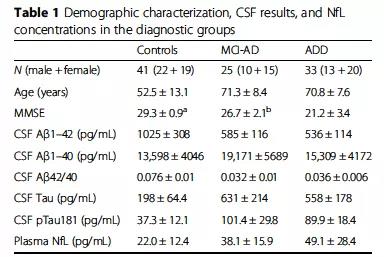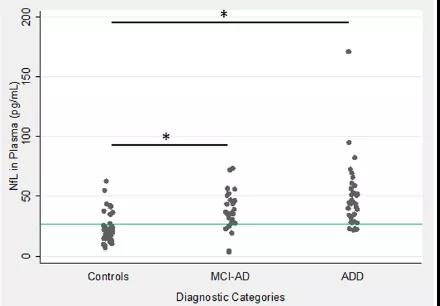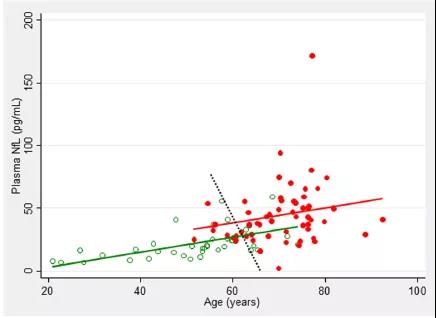SimoaTM (Single Molecular Array) technology is an ultra-sensitive protein detection and research diagnostic platform based on single-molecule immunoarray technology , and its sensitivity is more than 1000 times higher than traditional ELISA technology. This technology brings protein detection technology into the era of single molecule and digital detection, and becomes the true king of the Feike-class ultra-low abundance protein detection field, mainly used in neurological diseases, tumors, inflammation, infectious diseases and cardiovascular diseases. And other fields.
Alzheimer disease (AD) is a progressive degenerative neurological degenerative disease. At present, there are about 5 million AD patients in China, and every 5 people in the 65-year-old population One person has mild cognitive impairment. Since the course of AD is an irreversible process, there are no effective treatments and means to date, so it is extremely important to do early screening and diagnosis. Here, Xiaobian will introduce how SimoaTM technology can help screen and study Alzheimer's disease.
topic:
Plasma neurofilament light as a potential biomarker of neurodegeneration in Alzheimer's diseas
magazine:
Alzheimer's Research & Therapy
Impact factor: 8.23
Research institute:
Erlangen-Nuremberg University, Germany, Bialystok Medical School, Poland
Research Background:
At present, the early diagnosis of AD mainly depends on cerebrospinal fluid (CSF), because CSF can directly reflect brain-specific activities and pathological changes of proteins/peptides. However, due to the limitations of CSF sampling, it is difficult to use as a screening tool in early asymptomatic cases and is difficult to use for repeated monitoring of disease progression. Therefore, early diagnosis of AD urgently requires the development of blood-based biomarkers for targeted and relatively non-invasive screening assays.
Neurofilament (NF) is a major component of the axon cytoskeleton and consists of three different molecular weight protein chains: light chain (NfL), intermediate chain, and heavy chain. NF is a highly phosphorylated protein and the degree of phosphorylation determines the diameter of the axon. Axonal damage results in the release of NF molecules into the extracellular space and into the body fluids, such as CSF or plasma. Therefore, the increase in plasma NfL concentration may be due to neurodegeneration. Recently, scientists from Germany used the SimoaTM technology to detect the amount of NfL in plasma to screen for AD.
research method:
Plasma samples from patients with mild cognitive dysfunction (MCI), early dementia (ADD), and non-enhanced control AD ​​were collected, and the concentration of NfL in the samples was measured on the SimoaTM technology platform. Four nerves in the CSF were detected by ELISA. The contents of the classical markers amyloid β (Aβ) 1–42, Aβ42/40, Tau and pTau181 were compared. To validate the results of the analysis, the study further tested the effect of different pre-analytical sample processing procedures (repeated freezing/thawing, room temperature or refrigerator storage) on plasma NfL concentrations.
Research result:
1 The content of Nfl in plasma was significantly higher in MCI-AD group and ADD group than in control group.
The level of NfL in plasma was 38.1±15.9 pg/mL and 49.1±28.4 pg/mL in the MCI-AD group and the ADD group, respectively, which was significantly higher than that of the healthy control group (22.0±12.4 pg/mL). The contents are shown in Table 1 and Figure 1. 
Table 1 Demographic characteristics of three groups, CSF biomarker results and NfL concentration statistics in this study
Aβ: amyloid β; MMSE: simple mental state checklist

Figure 1: Unadjusted neurofilament light chain (NFL) concentrations in three groups. The concentration of the ADD group was close to a higher critical value than the MCI-AD group. The green horizontal line represents the cutoff value of the largest Youden index (25.7 pg/ml), so the diagnostic accuracy of the control group and AD (MCI-AD and ADD) was 82%. *p< 0.05.
The researchers combined the MCI-AD and ADD groups into one diagnostic category, the AD group. The NfL concentration is plotted as a dot by age, as shown in Figure 2. The results showed a highly significant correlation between NfL concentration and age (Ï = 0.65, p < 0.001). 
Figure 2: Relationship between plasma NfL levels and age in control (green) and AD patients (combination group of MCI-AD and ADD, red). The black dashed line is the best separation for the two groups based on Fisher's LDA linear discrimination.
2 Plasma NFL as a potential AD biomarker with sensitivity, specificity and accuracy

Figure 3: a ROC curve of control and AD in the absence of adjustment; b Sensitivity (blue), specificity (brown) and accuracy (green) of NfL as an early screening marker for AD as a function of age
Area under AUC curve; CI confidence interval; SE standard error
Figure 3 shows the performance of plasma NfL concentrations in AD patients with positive CSF biomarkers and controls with negative CSF biomarkers. The AUC of the ROC curve of the control group and the diseased group was larger (0.853, 95% confidence interval 0.772–0.934; Figure 3a). After introducing age into the model of the ROC curve, AUC increased significantly (p=0.055) to 0.920 (95% CI 0.869–0.970). At the maximum cut-off point of the Youden index: 25.7 pg/ml, the unconditional sensitivity, specificity, and accuracy of NfL in plasma as an early screening marker for AD were 0.84, 0.78, and 0.82, respectively. Taking into account the age differences between the groups in this study, the researchers therefore modeled the performance as a function of age (Fig. 3b). With age, the sensitivity increased from 0.61 in 50 years to 0.91 in 80 years, and the specificity decreased from 0.89 to 0.20, respectively, which made the overall accuracy of the test almost unchanged (0.84 and 0.80 for 50 and 80, respectively). .
Research result:
A total of 25 patients with mild MCI-AD, 33 patients with ADD, and 41 healthy controls were included in the study. At the same time, the researchers used ELISA to detect the content of four neuro-related classical markers Aβ1–42, Aβ42/40, Tau and pTau181 in CSF. The content of NfL in plasma was 38.1±15.9 pg/mL and 49.1±28.4 pg/mL in MCI-AD group and ADD group, respectively, which was significantly higher than that of healthy control group (22.0±12.4 pg/mL). The test results were consistent with the four markers in the CSF. These results are also consistent with recent published findings on sporadic AD and familial AD (FAD), suggesting that blood sampling can replace cerebrospinal fluid testing. Moreover, plasma NFL concentrations were also found to be positively correlated with age, consistent with previously reported plasma and cerebrospinal fluid studies. In addition, in order to verify the analysis results, the effects of different pretreatments (repeated freezing/thawing, room temperature or refrigerator storage) on plasma NfL concentration before analysis were further tested. The detailed results are shown in the original text.
Because plasma is more convenient and faster than cerebrospinal fluid, ultra-sensitive SimoaTM technology can be used to change the way AD is diagnosed. This makes NfL a molecular marker for AD screening, and finds patients who have no symptoms of disease in the early stage, so that patients can receive timely and effective treatment.
With its high-sensitivity immunoassay technology, the SimoaTM platform has developed products that detect AD-related cytokines such as NfL, Abeta40, Abeta42, and Tau, which can detect not only the above-mentioned factors in cerebrospinal fluid, but also peripheral blood. The change in concentration provides the possibility of simpler and more accurate blood testing.
Shanghai Biochip Co., Ltd. will introduce the SimoaTM platform, which will use ultra-sensitive immunoassay technology to increase cooperation with clinical clinics in the detection of new biomarkers for neurological diseases and blood screening, and promote the advancement of testing technology and assist in precision medicine. development of.
Next, stay tuned, we will continue to organize the application of the SimaoTM ​​ultra-micro protein detection platform for nerve, tumor, inflammation, infectious diseases and cardiovascular diseases!
Hair Removal Machine,Hair Removal Device,Best Hair Removal Device,Laser Hair Removal Device
Shenzhen Jie Zhong Lian Investment Co., Ltd. , https://www.szmeizons.com